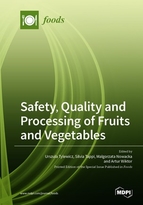Safety, Quality and Processing of Fruits and Vegetables
A special issue of Foods (ISSN 2304-8158). This special issue belongs to the section "Food Quality and Safety".
Deadline for manuscript submissions: closed (1 June 2019) | Viewed by 74057
Special Issue Editors
Interests: non-thermal technologies for fruit and vegetable processing (pulsed electric field, ultrasound, vacuum impregnation, osmotic dehydration, high pressure homogenization); waste and byproduct valorization; sustainable food production
Special Issues, Collections and Topics in MDPI journals
Interests: non-thermal processing; emerging technologies; food quality; food shelf life;
Special Issues, Collections and Topics in MDPI journals
Interests: non-thermal technologies such as ultrasound and pulsed electric field; osmotic dehydration; drying; design new products; sustainable methods of food production
Special Issues, Collections and Topics in MDPI journals
Interests: non-thermal processing methods; pulsed electric field; drying; food; ultrasound
Special Issues, Collections and Topics in MDPI journals
Special Issue Information
Dear Colleagues,
Nowadays, one of the main objectives of the fruit and vegetable industry is to develop novel products with high quality, safety, and optimal nutritional characteristics in order to respond with efficiency to the increasing consumer expectations. In fact, in the last years, consumers have become more exigent and demand high-quality and convenient food products with natural flavours and taste, free from additives and preservatives.
Various emerging, unconventional technologies (e.g., pulsed electric field, ohmic heating ultrasound, osmotic dehydration, microwave drying, etc.) allow the processing of fruits and vegetables, increasing their stability while preserving at the same time their thermolabile nutrients, flavour, texture, and overall quality.
However, there is still a lack of detailed information about the chemico-physical and metabolic response of fruits and vegetables to these processing technologies, consumer acceptance, some safety aspects, and process optimization.
Therefore, we would like to invite authors to contribute original research articles as well as review articles focused on safety aspects, quality evaluation, and emerging processing technologies for fruits and vegetables.
Dr. Urszula Tylewicz
Dr. Silvia Tappi
Dr. Malgorzata Nowacka
Dr. Artur Wiktor
Guest Editors
Manuscript Submission Information
Manuscripts should be submitted online at www.mdpi.com by registering and logging in to this website. Once you are registered, click here to go to the submission form. Manuscripts can be submitted until the deadline. All submissions that pass pre-check are peer-reviewed. Accepted papers will be published continuously in the journal (as soon as accepted) and will be listed together on the special issue website. Research articles, review articles as well as short communications are invited. For planned papers, a title and short abstract (about 100 words) can be sent to the Editorial Office for announcement on this website.
Submitted manuscripts should not have been published previously, nor be under consideration for publication elsewhere (except conference proceedings papers). All manuscripts are thoroughly refereed through a single-blind peer-review process. A guide for authors and other relevant information for submission of manuscripts is available on the Instructions for Authors page. Foods is an international peer-reviewed open access semimonthly journal published by MDPI.
Please visit the Instructions for Authors page before submitting a manuscript. The Article Processing Charge (APC) for publication in this open access journal is 2900 CHF (Swiss Francs). Submitted papers should be well formatted and use good English. Authors may use MDPI's English editing service prior to publication or during author revisions.
Keywords
- fruits
- vegetables
- unconventional processing
- emerging technologies
- quality
- safety










